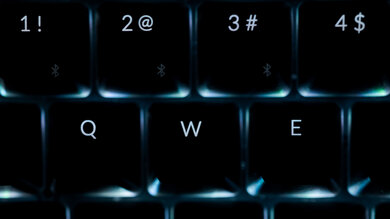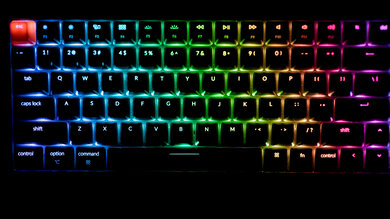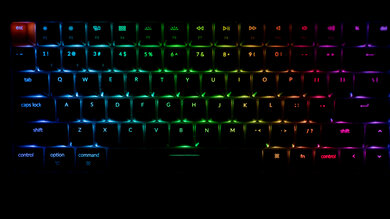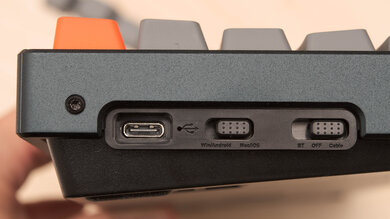The Keychron K2 (Version 2) is a decent entry-level mechanical keyboard. Its small and compact design makes it fairly easy to carry around, and you shouldn't have to worry about damaging it thanks to its excellent build quality. It's designed with macOS users in mind, but it comes with extra Windows keycaps as well. It works fully on both macOS and Windows, and only certain function keys don't work on mobile operating systems. It can connect with up to three devices at once via Bluetooth. Unfortunately, it doesn't have dedicated software, and you can't program any macros for gaming. Our unit has tactile Gateron Brown switches, and you can also get it with clicky Blue and linear Red switches. Unfortunately, the latency is a bit high, even when using a wired connection, which might disappoint serious gamers.
Our Verdict
The Keychron K2 is good for gaming; however, the latency is a bit high, even over a wired connection. It should be fine for most casual gamers, but it might disappoint serious, competitive gamers. It has full RGB backlighting, but without dedicated software, you can't reprogram any keys.
- Full RGB backlighting.
- Light operating force.
- No dedicated software or macro-programmable keys.
- Lacks wrist rest.
- Slightly high latency.
The Keychron K2 is good for mobile use. It can be paired with up to three devices at once, and except for some function keys, it works properly on most common mobile operating systems. It's small, light, and it has an excellent build quality, so you shouldn't have to worry about damaging it during travel.
- Compatible with most popular operating systems.
- Multi-device pairing with three devices.
- Small and compact design.
- Wireless connectivity.
- Certain function keys don't work on mobile devices.
The Keychron K2 is good for office use. The unit we tested has Gateron Brown switches, which provide a great typing experience, and you can get it with other switch types if you prefer. It's well-built and has okay ergonomics with two incline settings, but it doesn't come with a wrist rest. It's also fully compatible with both macOS and Windows.
- Compatible with most popular operating systems.
- Great typing quality.
- Excellent build quality.
- Lacks wrist rest.
The Keychron K2 is good for programming. The keys are stable and the Gateron Brown switches on our unit provide a great typing experience. It's well-built with a solid aluminum frame and has two incline settings, but it doesn't come with a wrist rest. Sadly, it doesn't come with dedicated software, and you can't reprogram any keys.
- Full RGB backlighting.
- Great typing quality.
- Excellent build quality.
- No dedicated software or macro-programmable keys.
- Lacks wrist rest.
The Keychron K2 is okay for use with a home theater PC. It has Bluetooth connectivity, so you can pair it to a wide variety of devices, and you can keep your setup wire-free. However, it doesn't have a trackpad for navigation.
- Full RGB backlighting.
- Wireless connectivity.
- No trackpad.
Changelog
- Updated Mar 05, 2021: Converted to Test Bench 1.0.
- Updated Jan 06, 2021: Review published.
- Updated Jan 04, 2021: Early access published.
- Updated Dec 21, 2020: Our testers have started testing this product.
Check Price
Differences Between Sizes And Variants
We tested the Keychron K2 V2 with an aluminum frame, RGB backlighting, and Gateron Brown switches. It's available in a few different variants, including a hot-swappable version that allows you to quickly change the switches without soldering. The differences between the versions are listed below, and the build quality, typing experience, and typing noise may change depending on which model and switch type you get. It's the updated version of the Keychron K2 V1, which doesn't have an incline frame or a Caps Lock indicator light.
Keychron sells extra accessories for the K2 V2 mechanical keyboard. You can get a wrist rest and a set of PBT keycaps directly from their website, so your experience may vary with these extra parts.
| Model | Keycap Color | Backlighting | Frame Material | Gateron Switches |
|---|---|---|---|---|
| Keychron K2 | Light/Dark Gray | RGB | Aluminum | Red, Brown, Blue |
| Keychron K2 | Light/Dark Gray | White | Plastic | Red, Brown, Blue |
| Keychron K2 | Light/Dark Gray | RGB | Plastic | Red, Brown, Blue |
| Keychron K2 Hot-Swappable | White/Black | RGB | Aluminum | Red, Brown, Blue |
| Keychron K2 Hot-Swappable | White/Black | White | Plastic | Red, Brown, Blue |
If someone notices that their unit doesn't correspond to our review, please let us know in the discussions and we'll update the review. You can see the label for our unit here.
Popular Keyboard Comparisons
The Keychron K2 is a decent, entry-level mechanical keyboard, and it's a better choice for mobile devices than the Keychron K4 or Keychron K8 because it's smaller and lighter to carry around. You can get it with a few different switch types, but sadly, you can't reprogram any of its keys, which is disappointing if you're a gamer. Also see our recommendations for the best keyboards for writers, the best mechanical keyboards, and the best keyboards for Mac.
The Keychron K3 and the Keychron K2 (Version 2) are two very similar keyboards, except the K3 has low-profile switches while the K2 has normal-sized ones. The K3 has better ergonomics because its lower profile makes it comfortable to type on even without a wrist rest. It's also available in a wider range of switch types, including optical ones. However, the K2 offers better typing quality and feels better built.
The Keychron K2 (Version 2) is essentially a bigger version of the Keychron K6. The K2 is a 75% keyboard with a row of dedicated function keys, while the K6 is 65%. They're nearly identical in features, but the K6 has lower latency, making it a better choice for gaming.
The Keychron K2 (Version 2) and the Keychron Q1 are both 75% compact boards, but the Q1 is slightly larger due to its more spaced-out navigation keys and function row keys. You can use the K6 wirelessly via Bluetooth and pair it with up to three devices at once. Also, the K2 has more incline settings, and thanks to its Gateron Brown switches' transparent casing, white backlighting looks white, while the Gateron Phantom switches on our Q1 unit have a brown casing, making white lighting look red. On the other hand, the Q1 is hot-swappable, so you can swap out the switches with whatever you prefer, and it comes with customization software to set macros to any key. Also, while we bought the fully-assembled variant, the Q1 has a barebones version.
The Keychron K2 (Version 2) and the Keychron K8 are essentially the same keyboard in two different sizes. The K2 is 75%, while the K8 is 80%. The K2 is available with various Gateron switches, but the K8 has both Gateron and Keychron Optical switch options. That said, both keyboards have a hot-swappable variant that lets you change the switches without soldering. Latency is better on the K8, but the difference shouldn't be noticeable to most people.
Test Results

It's a small, 75% compact keyboard that has a function row, Page Up/Down, Home, End, and arrow keys. It's light and won't take up much space on your desk. If you want a more compact model, check out the 70%-sized Keychron K14 or the 60%-sized Keychron K12.
The build quality is excellent. The aluminum frame feels very sturdy and doesn't flex at all. The keys wobble a bit, but they don't rattle. The doubleshot ABS keycaps are just okay and feel like the weakest part of the build. That said, you can buy extra PBT keycaps from Keychron's website, or you can check out the Keychron Q2, which has PBT keycaps included in the fully-assembled variant. The feet feel sturdy and shouldn't collapse when you push the keyboard.
The Keychron K2 Version 2 has okay ergonomics. It has a fairly high profile, so some people might need a wrist rest to avoid getting wrist fatigue. Its frame is slightly inclined, which is one of the upgrades from the first version of the K2. Unfortunately, it doesn't come with one, but you can buy a wooden one from Keychron's website. There's also a low-profile version of this board, the Keychron K3 (Version 2), that has better ergonomics.
The Keychron K2 has full RGB backlighting with individually-lit keys. You can cycle through brightness settings and lighting effects using the Fn and function keys. It doesn't get bright enough to make the colors stand out in a well-lit room.
It comes with a detachable USB-C cable, and the keyboard connector has a 90-degree angle, so you don't bend the wire when it's plugged in. The cable is braided and retains kinks from the packaging.
The Keychron K2 can connect with up to three devices at once via Bluetooth, or you can use it wired while charging. The battery is advertised to last up to 240 hours with the backlight turned off.
The Keychron K2 doesn't have many extra features. There are media hotkeys, but you can't reprogram any buttons. Keychron recommends using third-party software to remap the keys. There are switches on the left side to use it in the Windows/Android or the mac/iOS modes and to use it wirelessly or wired. If having dedicated emoji keys is something you would enjoy, check out the Logitech POP Keys. For a more customizable and hot-swappable wired board, check out the Keychron Q1.
The unit we tested has tactile Gateron Brown switches, but it's also available with clicky Gateron Blue and linear Red switches. It's similar to the Gateron Brown switches on the Keychron K6 and Keychron K8. They don't require a lot of force to actuate, and they provide good tactile feedback. If you prefer something with low profile switches, then look into the Keychron K3.
The Gateron Brown switches on our unit provide a great typing experience. They offer good tactile feedback, and it's also available with Gateron Red and Blue switches, so you can get the ones you prefer. The keys are stable, but the spacebar wobbles just a bit. The compact 75% size may take some time to get used to, especially if you use non-alphanumeric keys, such as Page Up and Page Down, which are positioned differently than on standard full-sized keyboards. The right Shift key is smaller than the left Shift, so that may cause an increase in typos when you first use it. The function row is the same height as the number row instead of being slightly taller like on most keyboards, so it may feel different for some, but it shouldn't be too much of an issue. The ABS keycaps feel slippery, but you can get an extra set of PBT keycaps. The keys are light to press, and despite having a high profile, it shouldn't be too tiring typing on them for long periods. If you notice some fatigue, you can also get a wrist rest separately.
Our unit with Gateron Brown switches is quiet and shouldn't bother those around you. However, we expect the Gateron Blue switches to be louder, similar to the Cherry MX Blue switches on the Ducky One 2 SF.
The Keychron K2 has decent latency. It's better to use the wired connection for gaming, but even then, it might still be too high for competitive gamers.
Keychron K2 doesn't come with dedicated software to customize the RGB lighting or reprogram keys. However, Keychron recommends using third-party software to remap keys. In the manual, they recommend Karabiner for macOS and SharpKeys for Windows, but we don't test for these programs.
The Keychron K2 is fully compatible with both Windows and macOS, as long as you set the keyboard to the proper mode with the switch on the left side. The F3 and F4 keys don't work on iOS or iPadOS. You should set the OS slider to 'mac/iOS' if you're using it with Linux, but the display brightness up/down keys don't work. If you set the keyboard to the 'Windows' mode on Linux, all of the function keys, as well as the display brightness up/down, don't work.









